Last week, LAPD released a carefully curated critical incident briefing on the horrific crash that killed Luis Espinoza - a 26-year-old man who the department said may have been experiencing homelessness. Espinoza had been crossing Century at McKinley at dusk on December 8, 2023 when he was struck by an officer rushing toward Watts in her patrol vehicle on what the L.A. Times has reported was a non-emergency call. While the briefing does shed some light on how the terrible crash unfolded, it is more notable for what the department chose not to include.
As a general rule, LAPD has used its critical incident briefings as opportunities to refine their narratives and present the department and the officers’ actions in the best possible light. This case is no different.
Outside of the select dash and security cam footage provided, the briefing offers no new information about the identity of the officer, about whose request she was responding to, about whether she (or others) had abused "Code 3" (emergency lights and siren) before, or about whether the charges she will face will be tied to Espinoza's death, the improper use of "Code 3," or both.
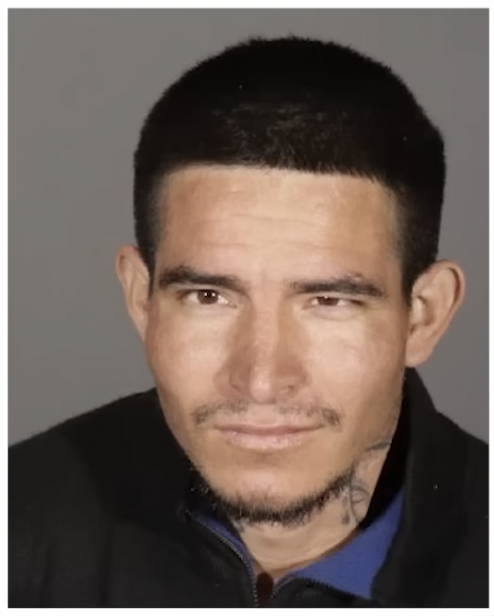
Instead, it implies Espinoza bears some of the responsibility for his own death while depicting the department as having been all-hands-on-deck to assist a fallen member of the public.
In previous statements, LAPD had already insinuated Espinoza bore some of the blame for not having the right of way and for being “outside of the marked crosswalk” when he was hit. But they had at least acknowledged he was “crossing” the street.
The grainy security cam footage provided in the briefing confirms Espinoza was indeed attempting to "cross" the street.
He is seen successfully dodging westbound traffic on a moderately busy Century Boulevard just west of McKinley at around 5 p.m. when the emergency lights of an eastbound patrol vehicle suddenly come screaming into view. It is moving too fast for him to outrun. He is caught, tossed up onto the windshield, and then flung forward onto the pavement, where he skids approximately 100 feet along the gutter before coming to a rest.
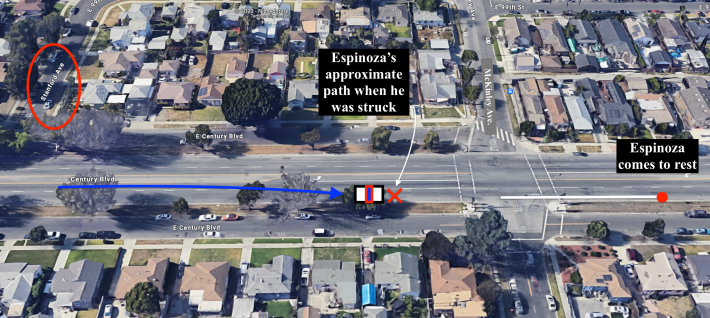
Yet in the briefing, Captain Kelly Muñiz, Commanding Officer of the Media Relations Division, describes Espinoza as “running southbound on Century Boulevard” - language that suggests he was aimlessly running amok.
The briefing also supplies a graphic that depicts him running headlong into the vehicle.
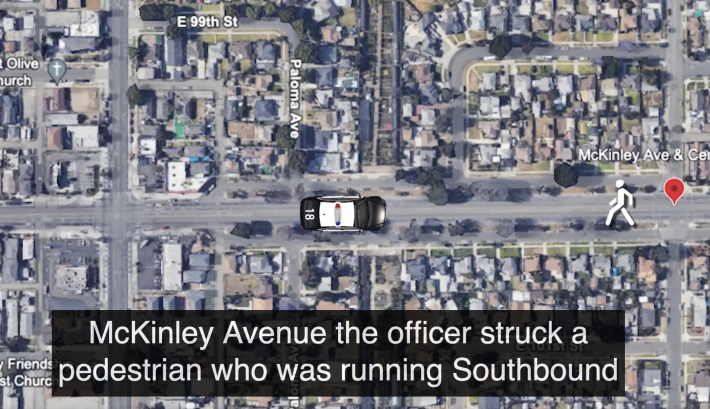
Troublingly, the department opted not to be more transparent about just how egregious the officer’s behavior was in a community already overburdened by traffic violence.
Carved up by wide streets that encourage speeding and street racing, South L.A. can be incredibly hazardous for all road users. This is especially true for pedestrians and cyclists, and particularly for those experiencing homelessness. In 2023, the South Bureau logged the highest number of pedestrian and cyclist deaths resulting from collisions with motor vehicles (56 out of 190 total deaths). New Year's Eve proved particularly tragic for the region, with three separate collisions within an hour resulting in multiple casualties, including the orphaning of a one-year-old child.
Leveraging the badge to blaze through the streets the way she did indicates an utter disregard for the safety and well-being of the people the officer was tasked with serving. For many, it is also emblematic of the entitlement with which LAPD moves in the South L.A. community. The department's decision to shield both the officer and the Community Safety Partnership Bureau (CSP) from greater scrutiny by releasing so little information only adds to that concern.
The briefing includes just 17 seconds of dash cam footage from the officer's mile-plus long trajectory. It does not specify her speed, how far she traveled against oncoming traffic, how many red lights she ran, or whether her sirens were deployed the whole time. It omits discussion of LAPD’s “Code 3” policy - including the strict rules governing a Code 3 response and the penalties associated with abusing it. Even the way the help calls are played over the security cam footage appears to misrepresent when those calls were made.
When the dash cam kicks in at 17:00:06, the officer is already barreling down the center turn lane on Century towards a red light at Grand (below).

She barely slows down as she moves through the intersection. She then veers to the left, into the opposing lane, and hits the gas again, driving against traffic to bypass the line of eastbound cars seen waiting at the red light at Broadway (below).
The dashcam fades out just a few seconds later, at 17:00:23, as she accelerates toward the red light. Presumably she has not turned the dashcam off herself - it goes on automatically with the emergency lights/siren. But LAPD does not provide any more of that footage, even though she is still over a mile - and about a minute and a half, per security cam time stamps - from McKinley at this point.
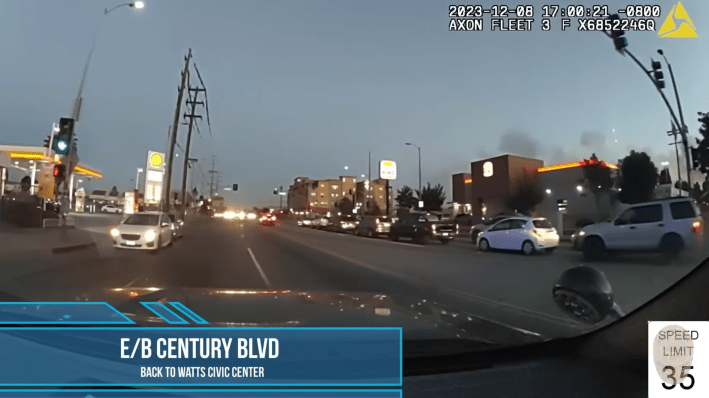
The next clip is of the officer in the left lane as she flies through a residential section of Century (below).
Although the briefing does not indicate the officer's location, the intersection seen at the top left of the frame is Stanford Avenue. Which means she is just seconds away - 400 feet or less - from striking Espinoza as she exits frame.
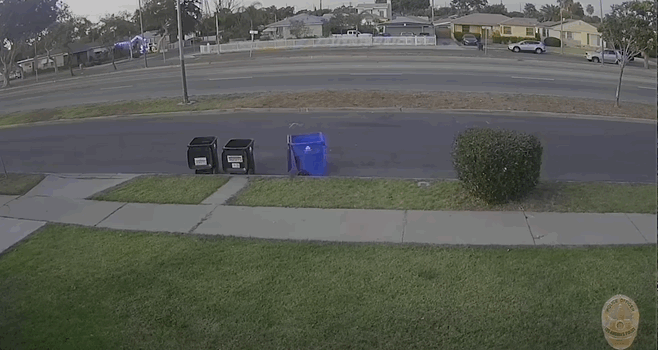
Per LAPD Policy, “Code 3” – the activation of lights and sirens to assist an officer in getting to the scene of an emergency – does not exempt an officer “from the duty to drive with due regard for the safety” of other road users. Officers are expected to take particular care at intersections, slowing down and clearing red lights lane by lane to ensure they can pass through safely.
They are expected to slow down when the lights are green for the same reason.
Yet the officer does not appear to check her speed as she comes into view on another home security cam (below). Although Espinoza can be seen opening up into a full-out sprint, she closes in on him too quickly. [Upon several rewinds and slo-mo rewatches, it also appears she may not have hit the brakes until making contact (or just prior to making contact) with Espinoza.]
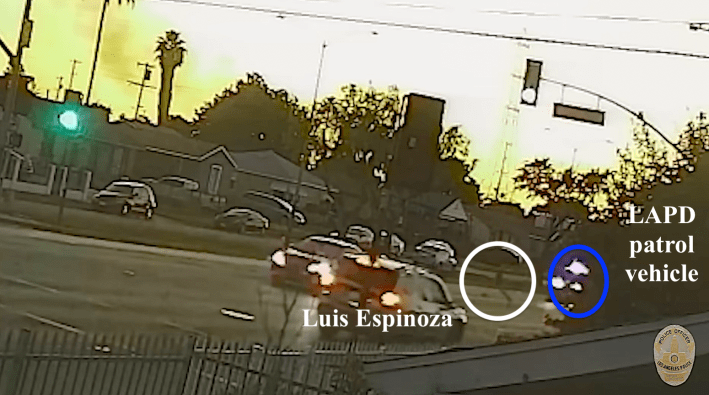
When she does finally slow to a stop, she remains in her vehicle for over a minute without rendering aid.
The briefing implies she immediately requested assistance by syncing audio of her initial radio calls to footage of the moment both Espinoza and the patrol vehicle come to a rest. However, audio of the officer's call matched to a citizen-streamed scanner suggests the initial calls to dispatch may have been made approximately 23 seconds later. A call time-stamped 5:02:21 on the security cam in the briefing is heard at 5:02:44 on the scanner, indicating there may be a significant discrepancy, assuming both clocks in question are correct. [The citizen scanner does not capture all the calls, but at least one other call had the same 23-second discrepancy; LAPD has declined to provide clarifications or release the full set of radio calls and time stamps.]
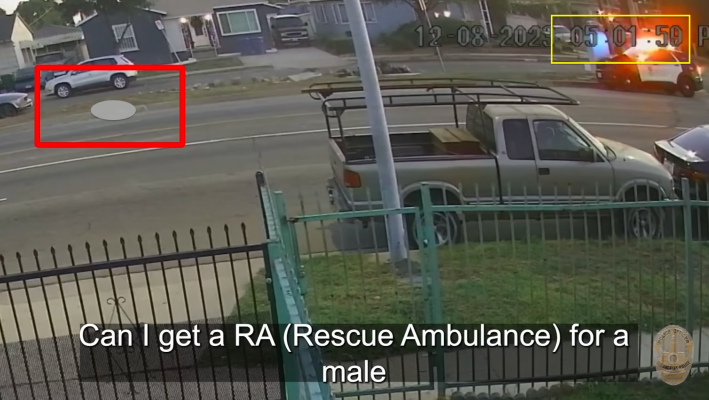
The subsequent set of radio calls from officers responding that they are headed to the scene is another unusual addition to the briefing.
Officers have come under fire for not rendering aid in a timely way (see Streetsblog's reporting on how officers allowed Earl Roots to languish for four hours after collapsing his lung) and for not showing a reverence for human life (see an L.A. Times story on officers joking about earning overtime after shooting Christian Arriola-Gomez). "En route" calls paired with footage of Espinoza lying unattended in the street give the impression a cavalcade of help is on the way. In reality, the officer does not begin chest compressions on Espinoza until a minute and a half after striking him.
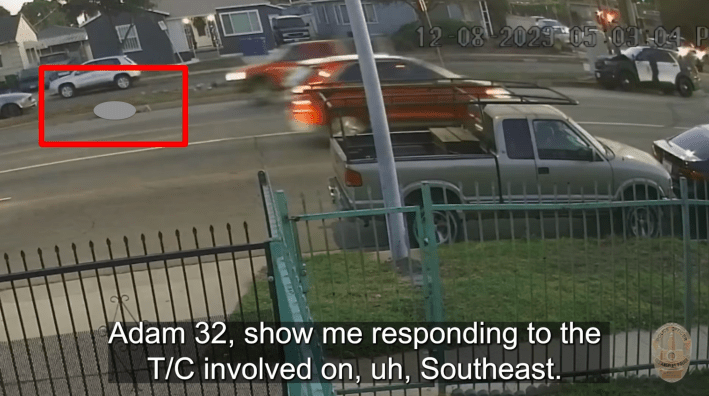
_______________
The LAPD's lack of transparency is unfortunately not a surprise.
Initial reports on the crash, like the segment below, signaled the department was going to release the bare minimum of information: e.g. that a patrol car had collided with a pedestrian, the pedestrian had died, the incident was being investigated, and the 30-year-old officer either had been taken to the hospital with non-life-threatening injuries, per a department spokesperson's statement to the L.A. Times, or was uninjured.
Four days after the crash, details remained scarce. In a statement posted to LAPD's website, Chief Michel Moore took the unusual step of declaring he had "very serious concerns regarding the officer’s driving leading up to the collision" and indicated the case would be presented to the District Attorney "for filing considerations" when the investigation was complete. The statement did not spell out what Moore's concerns were, however. There was also no reference to the officer - now identified in the statement as having been assigned to the Community Safety Partnership Bureau - being taken to the hospital (an indication that she likely had not).
Moore remained tight-lipped about the incident during his regular report to the Police Commission that same day (and again that afternoon, during a media availability briefing). He reiterated his concerns about the officer’s conduct and confirmed she had "inappropriately activated her emergency lights" while driving "at a high rate of speed," but gave no explanation for why she had done so. He did walk back claims the officer had been taken to the hospital, however, saying she had been treated for minor injuries at the scene. Members of the Police Commission expressed their condolences for Espinoza's family but did not press the Chief for more details.
It took an L.A. Times report to fill in some of the blanks the Chief would not. Per their sources, the officer had been "running an errand for a member of a youth sports team” affiliated with the CSP program in Watts, not responding to an emergency. [Of note, CSP officers are among those heard telling dispatch they are responding to the crash scene. It is unknown if any of those who responded had any connection to the errand the officer was running.]
The continued unwillingness of the department to be more forthcoming in the face of obvious and egregious misconduct remains a significant obstacle to building public trust.
Whether that will change with Chief Michel Moore's departure at the end of February - announced suddenly last Friday - is an open question. In the meanwhile, LAPD has declined to release the remainder of the dash cam footage or offer any other clarifications.
UPDATED: 1/26/24: Per the LB Post, the family of Luis Espinoza has filed a lawsuit against the department "alleging the city’s police department fails to properly train its employees on how to drive safely."
To see the LAPD's critical incident briefing, click here.







